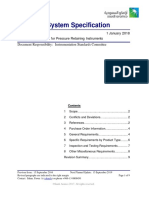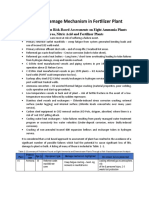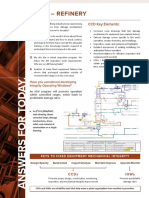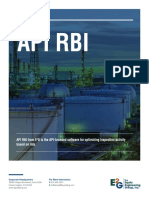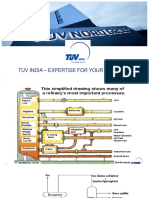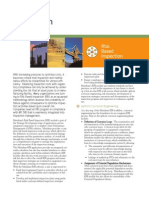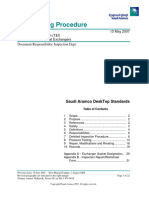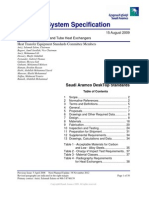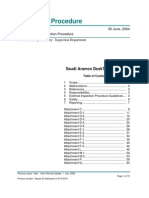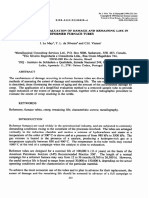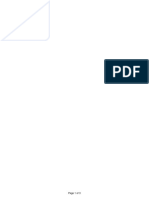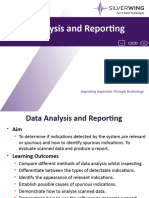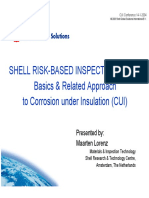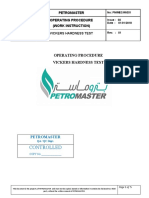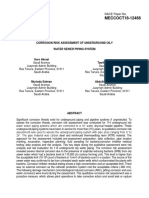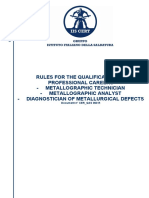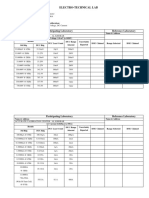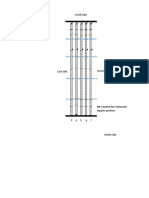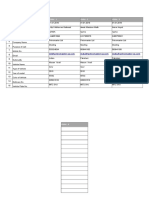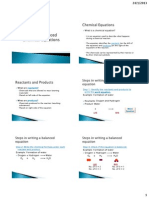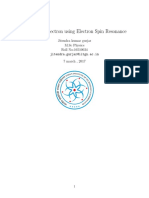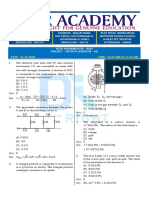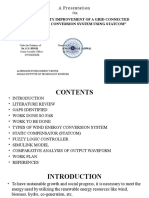SAEP-355 Replica PDF
Uploaded by
Owais Manzoor MalikSAEP-355 Replica PDF
Uploaded by
Owais Manzoor MalikEngineering Procedure
SAEP-355 11 April 2009
Field Metallography and Hardness Testing
Materials and Corrosion Control Standards Committee Members
Anezi, Mohammed Ali, Chairman
Rumaih, Abdullah Mohammad, Vice Chairman
Lobley, Graham Russel
Mehdi, Mauyed Sahib
Abdul Hadi, Abdul Latif Ibrahim
Mugbel, Wajdi Mohammad
Niemeyer, Dennis Charles
Omari, Ahmad Saleh
Bannai, Nabeel Saad
Rao, Sanyasi
Buraiki, Iyad Abdulrazzak
Kermad, Abdelhak
Tems, Robin Douglas
Dossary, Hadi Mohammed
Sharif, Talal Mahmoud
Cruz, Czar Ivan Tecson
Rammah, Ahmad Saleh
Burgess, Brian Wayne
Saudi Aramco DeskTop Standards
Table of Contents
1 Scope............................................................. 2
2 Conflicts and Deviations................................ 2
3 References..................................................... 3
4 Definitions and Abbreviations........................ 3
5 Health and Safety.......................................... 4
6 Technical Procedures.................................... 7
7 Responsibilities and Requirements.............. 15
Appendix A – Replication Equipment Checklist 20
Previous Issue: 3 July 2007 Next Planned Update: 11 April 2014
Revised paragraphs are indicated in the right margin Page 1 of 20
Primary contact: Kermad, Abdelhak on 966-3-8760231
Copyright©Saudi Aramco 2009. All rights reserved.
Document Responsibility: Materials and Corrosion Control Standards Committee SAEP-355
Issue Date: 11 April 2009
Next Planned Update: 11 April 2014 Field Metallography and Hardness Testing
1 Scope
This procedure provides Saudi Aramco guidelines for performing satisfactory surface
replication for the purposes of in-situ metallographic examination or field
metallography and hardness testing on carbon and low-alloy steel plant equipment and
in-plant piping. The procedure is designed to reveal general microstructural features
such as those observed in new or aged metallic components; it is also tailored to help
the metallurgical engineer in the identification/categorization of surface-breaking
defects and flaws of fabrication or service-induced origin. The procedure is also
suitable for the assessment of high temperature equipment operating in the creep
domain. Replicas produced in accordance with this procedure will be acceptable to
ASTM E1351-01 (Production and Evaluation of Field Metallographic Replicas).
Important Requirements
It is noted that no company or industry certification is currently available to qualify
engineers/technicians to this procedure, i.e., for both field metallography and
hardness. CSD technicians are however adequately trained to follow the guidelines
laid herein.
Proponents requiring the undertaking of field metallography and hardness testing
may, in the first instance, request this service from the Materials Engineering Unit
of CSD by completing a service request available on CSD intranet webpage.
Alternatively, outside contractors may be utilized, subject to a qualification test by
CSD and satisfactory compliance with this procedure.
2 Conflicts and Deviations
2.1 Hardness testing carried out by TeleBrinell (hammer) as per other Standards,
e.g., SAES-W-010 [Welding Requirements for Pressure Vessels] and NACE
Standard RP0472 [Methods and Controls to Prevent In-Service Environmental
Cracking of Carbon Steel Weldments in Corrosive Petroleum Refining,
Environments], remain unaffected by this procedure. Hardness testing based on
these standards, i.e., SAES-W-010 and NACE RP0472 does not constitute a
deviation from this procedure. The hardness procedure laid out in this document
requires a high level of surface preparation and is only applicable when
undertaken in conjunction with field metallography.
2.2 Any conflicts between this Procedure and other applicable Saudi Aramco
Engineering Procedures (SAEPs), Saudi Aramco Engineering Standards
(SAESs), Saudi Aramco Materials System Specifications (SAMSSs), Saudi
Aramco Standard Drawings (SASDs), or industry standards, codes, and forms
shall be resolved in writing by the Company or Buyer Representative through
the Manager, Consulting Services Department of Saudi Aramco, Dhahran.
Page 2 of 20
Document Responsibility: Materials and Corrosion Control Standards Committee SAEP-355
Issue Date: 11 April 2009
Next Planned Update: 11 April 2014 Field Metallography and Hardness Testing
2.3 Direct all requests to deviate from this Procedure in writing to the Company or
Buyer Representative, who shall follow internal company procedure SAEP-302
and forward such requests to the Manager, Consulting Services Department of
Saudi Aramco, Dhahran.
2.4 This procedure is the property of Saudi Aramco. When replication services
cannot be provided by CSD to proponents and a contractor has to be used, this
contractor shall submit his own procedure for qualification by CSD.
3 References
The requirements contained in the following documents apply to the extent specified in
this procedure.
3.1 Saudi Aramco References
Saudi Aramco Engineering Procedure
SAEP-302 Instructions for Obtaining a Waiver of a
Mandatory Saudi Aramco Engineering
Requirement
SAEP-325 Inspection Requirements for Pressurized
Equipment
SAEP-335 Boiler Condition Assessment
Saudi Aramco Engineering Standard
SAES-W-010 Welding Requirements for Pressure Vessels
3.2 Industry Codes and Standards
American Society of Testing of Materials
ASTM E1351-01 Production and Evaluation of Field
Metallographic Replicas
ASTM A956-02 Standard Test Method for Leeb Hardness Testing
of Steel Products
National Association of Corrosion Engineers
NACE RP0472 Methods and Controls to Prevent In-Service
Environmental Cracking of Carbon Steel
Weldments in Corrosive Petroleum Refining
Environments
Page 3 of 20
Document Responsibility: Materials and Corrosion Control Standards Committee SAEP-355
Issue Date: 11 April 2009
Next Planned Update: 11 April 2014 Field Metallography and Hardness Testing
4 Definitions and Abbreviations
CSD: Consulting Services Department.
CSD Engineer: Metallurgical or Mechanical Engineer working in the Materials
Engineering Unit of CSD.
CSD or Metallurgical Technician: Technician working in the Metallurgical
Laboratory of CSD and trained in field metallography and hardness testing.
HAZ: Heat-Affected Zone.
Leeb Hardness Test: A dynamic hardness test method using a calibrated instrument
that impacts a spherically shaped ball or diamond tipped body with a fixed velocity
(generated by a spring force) onto a surface of the material under test. The ratio of the
rebound velocity to the impact velocity of the impact body is a measure of the hardness
of the material under test.
MEU: Materials Engineering Unit.
ME&CCD: Materials Engineering and Corrosion Control Division.
Proponent: Plant engineer, supervisor or manager for whom the work is being carried
out.
Replication: A form of Field Metallography, in which a replica image of the material
microstructure is made.
UCI: Ultrasonic Contact Impedance, a method that uses a diamond pyramid indenter to
leave an impression on the test surface. The indentation area is electronically detected
by measuring the shift of an ultrasonic frequency.
5 Health and Safety
5.1 This procedure involves grinding, use of chemicals and often work in confined
spaces or at heights. Care shall be exercised at all times to ensure personnel
safety is not at risk. In particular, the following shall be obeyed:
5.2 Health and Safety datasheets (or MSDS sheets) shall be obtained and complied
with by the CSD Engineer and Technician for all chemicals (solvents and
etchants) in use by the CSD Technician.
5.3 All personnel shall be familiar with the local site safety regulations; these shall
include knowledge of the emergency alarms, muster points, evacuation
procedures local warnings, etc.
Page 4 of 20
Document Responsibility: Materials and Corrosion Control Standards Committee SAEP-355
Issue Date: 11 April 2009
Next Planned Update: 11 April 2014 Field Metallography and Hardness Testing
5.4 All accidents and incidents (near misses or dangerous occurrences) shall be
reported to the local safety engineer.
5.5 All replication work shall be carried out in well-ventilated work areas.
5.5 Local site regulations shall be obeyed.
5.7 Adequate personal protection equipment shall be worn at all times when
grinding, polishing, etching and replicating, as follows:
a) Clothing – Full coverall boiler suits for general site conditions or dust
suits, as dictated by working environment;
b) Safety hat or helmet;
c) Safety footwear, i.e., with steel insert toe protectors which must not be
exposed or conducive to sparking;
d) Safety goggles when profiling/coarse grinding and flapping or safety
spectacles when fine grinding/polishing;
e) Hearing protection (muffs or ear plugs;
f) Gloves;
g) Correct type respirators in environments where potential breathing hazards
have been identified.
5.8 When taking replicas in equipment fired with vanadium-containing fuel oils,
e.g., boilers and heaters, adequate respiratory protection shall be worn to avoid
exposure to vanadium dust. It is the responsibility of the proponent's safety
engineer/coordinator or work permit issuer to declare the equipment safe for
entry after the appropriate checks have been carried out on the internal
atmosphere of the equipment.
5.9 Work must not commence prior to obtaining a hot work permit by an approved
Saudi Aramco hot work permit receiver.
5.10 Work must not be carried outside the validity of issued work permits. If
required, an extension to the work permit must be sought from the proponent's
issuer.
5.11 Chemicals – Field metallography involves use of chemicals such as acetone,
methanol, ethanol, hydrochloric, picric and nitric acids. Other chemicals may
also be used depending on the material type under investigation.
Page 5 of 20
Document Responsibility: Materials and Corrosion Control Standards Committee SAEP-355
Issue Date: 11 April 2009
Next Planned Update: 11 April 2014 Field Metallography and Hardness Testing
a) Where practical, every effort should be made to arrange for either
provision of chemicals by the proponent's chemical laboratories or local
supplier. This situation is sometimes unavoidable for distant areas, i.e.,
requiring air travel, e.g., Yanbu, Jeddah, Rabigh, Shaybah, etc., due to
Aramco Aviation and other airline restrictions.
b) If transportation of chemicals by car is unavoidable, then adequate
precautions against accidental breakage/spillage will be required. In small
quantities, i.e., total <5 liters, chemicals shall be carried in glass
"Winchesters" inside properly labeled plastic transport containers, inside a
secure metal box. When chemicals are required in large quantities, i.e.,
total >5 liters, these shall be carried in the original supplier's container and
packaging.
c) Preparation of chemicals, i.e., filling, mixing, etc., should be carried out in
a fume cupboard or a well-ventilated area.
d) Rubber/PVC gauntlet gloves and safety goggles must be worn when
handling chemicals. The use of a barrier cream is recommended on areas
of unprotected skin.
e) Disposal of unwanted/left-over chemicals must not be carried out without
prior-consultation with the Supervisor of the proponent's chemical
laboratory. In some cases, regulated disposal procedures are required. In
all cases, the local disposal procedures must be followed.
f) Electrical equipment must not be tampered with; any modification,
maintenance, repair or connection to local facility's supply must be carried
out by the proponent's electrical technician. Under no circumstances
should the CSD engineer or technician engage in electrical-related
maintenance work.
5.12 To avoid damage to CSD's field metallography electrical equipment and
facility's electrical supply system, the CSD engineer or technician must advise
the proponent's electrical technician about CSD's requirements for appropriate
voltage and power consumption, i.e., 110 or 220 volts, 1 kVA.
5.13 When performing rough grinding, the CSD engineer or technician must ensure
that the chemical-containing plastic bottles are adequately protected from the
sparks emitted by the grinding action. These bottles must either be placed in an
aluminum storage box or in an appropriately declared safe area.
5.14 Equally, care must be taken regarding the disposal of used solvent-impregnated
cotton wool swabs. These must be placed in a plastic garbage bag. Inadequate
measures can result in fire hazards to equipment and adjacent personnel.
Page 6 of 20
Document Responsibility: Materials and Corrosion Control Standards Committee SAEP-355
Issue Date: 11 April 2009
Next Planned Update: 11 April 2014 Field Metallography and Hardness Testing
5.15 It is the responsibility of the CSD engineer or technician to maintain a clean
working area during the field metallography process and ensure that all
"rubbish" is adequately disposed of at the end of the day or shift.
6 Technical Procedures
6.1 Field Metallography
A flow diagram outlining the field metallography procedure is shown in
Figure 1.
6.1.1 Equipment
A checklist of equipment normally required to perform field
metallography is given in Appendix A.
6.1.1.1 Rough/Fine Grinding
Grinding shall be carried out using electric or compressed air-
driven, hand held, angle grinders, in-line grinders and fine
grinding/polishing machines (e.g., Struers Transpol) approved
by Saudi Aramco. Successive stages of preparation normally
require fiber-reinforced abrasive discs, 80 and 180 grit flap
wheels; and P120, P220, P400 and P800 grinding discs/papers.
6.1.1.2 Polishing
Polishing shall be carried out using portable polishing
machines acceptable to Saudi Aramco. Successive stages of
polishing require 6-micron diamond paste on Mol cloths and 1
micron diamond paste on Nap cloths. A lapping lubricant is to
be applied by aerosol, waste bottle or trigger spray. Suitable
suppliers for these consumables are:
Grinding discs P50, P120, P220, P400 Struers (Tradi)
Grinding papers P800 (PSA backed) Buehler
Mol cloths Struers (Tramo)
Nap cloths Struers (Trapp)
Dur cloths Struers
Diamond Paste Engis Ltd (Hyprez)
Lapping lubricant Engis (Hyprez)
6.1.1.3 Etchant
Page 7 of 20
Document Responsibility: Materials and Corrosion Control Standards Committee SAEP-355
Issue Date: 11 April 2009
Next Planned Update: 11 April 2014 Field Metallography and Hardness Testing
This is usually applied from a wash bottle, trigger spray
(preferred) or by using a cotton wool swab. Typically, the
etchant used for low-allow ferritic steel is 2% Nital (nitric acid
in alcohol). If swab etching is used, care should be taken so as
to avoid scratching the polished replication area.
6.1.1.4 Solvent
A suitable solvent shall be used as a cleaning wash for
removing debris and etchant. Suitable solvents include acetone,
methanol and ethanol. Due to minor health risks associated
with using solvents, a suitable hand barrier cream shall be used
according to the manufacturers' instructions. When performing
polishing with diamond paste, it may be necessary to use
acetone as a final wash if difficulty is experienced with the
slow evaporation rate of methanol or ethanol.
Industrial Methylated Spirits (IMS) may be used during
grinding and polishing stages but should not be used during
etching and replication stages to avoid staining.
Acetone shall be used for replication purposes. Ethyl acetate
will be used in circumstances where higher ambient
temperatures (up to 60°C surface temperature) render the use
of acetone inappropriate.
Solvents shall be applied from a wash bottle or trigger spray.
6.1.1.5 Replication Material
Cellulose acetate film, thickness approximately 35 micron
(0.0014 inch) shall be used for replication. Suitable replication
material is that supplied by Agar Scientific Ltd (part No.
G255).
6.1.2 Procedure
6.1.2.1 General Grinding/Polishing
The various stages of grinding/polishing/etching/replication are
described below. A flow diagram for the Saudi Aramco
procedure is shown in Figure 1.
Each subsequent stage of grinding/polishing shall be carried out
at approximately 90° to the previous stage. This will allow any
remaining scratches from the previous stage to be observed.
Page 8 of 20
Document Responsibility: Materials and Corrosion Control Standards Committee SAEP-355
Issue Date: 11 April 2009
Next Planned Update: 11 April 2014 Field Metallography and Hardness Testing
Certain situations when access is poor will dictate that when
using flap wheels the full 90° displacement cannot be achieved.
Each stage shall be performed until all previous scratches and
inter-stage etching is removed beyond doubt. This may be
achieved by visual examination of the replica site for complete
removal of all scratches and then continuing the
grinding/polishing stage for a similar time. Excessive force on
the polishing tools shall be avoided. This will reduce any
surface deformation.
6.1.2.2 Cross-Weld Replicas
The site prepared for replication, i.e., fully polished, shall be
approximately 25 mm wide and extend for approximately
20 mm from the weld toe into the base material. Figure 2
shows a typical replica site outline. Replicas shall include 1st
base material/1st HAZ)/weld metal/2nd HAZ/2nd base
material.
6.1.2.3 Surface Profiling
Surface profiling by rough grinding is initially carried out to
provide a smooth, but not necessarily flat area. This operation
also permits the necessary elimination of surface effects such as
oxidation and corrosion. For other surface effects such as
carburization and decarburization, the CSD engineer must be
consulted to advice on the requirements to eliminate these
factors; one prime consideration regarding these effects is the
depth or penetration and accordingly specialist advice is
required so as not to compromise the integrity of the equipment
under investigation. On thick-section welded components, the
surface profiling will require removal of approximately 1 to 1½
mm from the weld toe. However, on thinner components, the
overall thickness shall not be reduced by more than
approximately 5%. Extreme care should be exercised when
surface profiling thin-walled tubing, e.g., process, boiler or
steam superheater tubes. If in doubt, the CSD engineer must be
consulted.
6.1.2.4 Rough Grinding (Flapping)
Coarse grinding marks shall be removed using 80-grit followed
by 180-grit flap wheels. Where component geometry does not
allow use of flap wheels, initial preparation shall use P50
grinding discs followed by P120 grinding discs. The
Page 9 of 20
Document Responsibility: Materials and Corrosion Control Standards Committee SAEP-355
Issue Date: 11 April 2009
Next Planned Update: 11 April 2014 Field Metallography and Hardness Testing
subsequent stage shall be a very heavy etch followed by
another P120 grinding. This latter stage is very important to
remove deformed material and shall be carried out at 90° to the
previous P120 disc or 180-grit flap wheel stage.
6.1.2.5 Inter-Stage Etching
Etching shall be performed using the etchant and equipment
described in Section 6.1.1.
Inter-stage etching shall be carried out between the stages of
fine grinding and polishing. To assist in an even material
removal, this shall be a heavy etch followed by a solvent wash.
This wash shall remove all previous grit and debris from the
replica site. The etch period is dependent on the material
composition, condition and ambient temperature. This period
shall be determined from experience and should result in
clearly visible HAZs. The duration is typically 10-30 seconds
and shall be confirmed by the CSD engineer or technician.
6.1.2.6 Fine Grinding
Subsequent stages of replica site preparation shall be carried
out using P220, P400 and P800 grinding discs or papers.
Each stage shall be followed by an inter-stage etch as described
in Section 6.1.2.5.
6.1.2.7 Polishing
Final stages of replica preparation shall be carried out using
6 micron and 1 micron diamond pastes. The 1-micron stage
shall be repeated at least once. The final 1-micron polish shall
be performed such that the cutting direction is perpendicular to
the weld interface; this is to reduce contamination scratches.
6.1.2.8 Cleaning of Polished Replica Site
Prior to surface examination, the replica site shall be carefully
cleaned with a solvent wash followed by a solvent-soaked
(cotton wool) swab. Several swab wipes will be required to
achieve an adequately cleaned surface. After each wipe, the
swab shall be discarded and a new one used for the next wipe.
Wipes shall be carried out gently and start at the center of the
replica site to avoid contamination and scratching.
Page 10 of 20
Document Responsibility: Materials and Corrosion Control Standards Committee SAEP-355
Issue Date: 11 April 2009
Next Planned Update: 11 April 2014 Field Metallography and Hardness Testing
6.1.2.9 Replication/Etching
Precautions shall be taken to ensure contamination of the
replication film with dust, skin oils and etchants is minimized.
At least three replicas shall be taken at different levels of
etching; the first replica site etch shall be "light". Under good
lighting, the microstructural variation shall be just apparent.
The etchant shall be applied as an even wash for an appropriate
duration; generally 5-10 seconds. The etchant shall be
thoroughly and evenly removed by a solvent wash.
a) Replica Application
Replicas shall be made by applying an Acetone wash to
the etched replica site and quickly, but carefully, laying
on the cellulose acetate film. Surface tension will cause
the film to be pulled down onto the replica site. Bubbles
in the replica shall be avoided when laying the film on the
site, by starting from one edge. For difficult geometries,
light finger pressure may be required to ensure adequate
contact of replica to surface.
b) Replica Removal and Storage
Replicas shall be left in place until they are no longer soft
and are easily removed. Ambient conditions will
determine the time required before removal. Typically, a
period of 5-10 minutes is required. Identification labels
(described in Section 5) shall be attached to the non-
contact (wrong) side of replicas before removing.
Replicas shall be removed by carefully peeling them from
the replica site to avoid tearing. Replicas shall then
immediately be placed flat in clean, re-sealable, plastic
bags. Identification labels shall remain securely attached
to replicas. Replicas shall be stored flat between the
pages of a hard-covered book. Alternatively, the replicas
may be mounted on glass slides as per ASTM E1351.
c) Successive Replication
At least two further replicas shall be made with "medium"
and "heavy" etches. After removal of the first replica, a
"medium" etch shall be made by repeating the procedure
Page 11 of 20
Document Responsibility: Materials and Corrosion Control Standards Committee SAEP-355
Issue Date: 11 April 2009
Next Planned Update: 11 April 2014 Field Metallography and Hardness Testing
described above on top of the first "light" etch (typically,
an additional 5-10 seconds etching time for each stage).
The microstructural variation across the weld interface
shall be clearly visible under good lighting. A "medium"
replica shall then be made. The procedure is then
repeated to produce a "heavy" etch.
Under certain circumstances, it may be necessary to make
a fourth "very heavily" etched replica, if the final etch
above does not appear to be sufficient. The "very heavy"
replica shall be in addition to, and not replace the "heavy"
replica.
In unusual circumstances, it may be considered necessary
to repeat replication at a given level of etch, e.g., when
replica is partly torn on removal, but otherwise good. A
repeat replica is acceptable providing it is clearly
identified as "repeat" by the CSD Technician.
d) Recording
Replicas shall be identified with a self-adhesive labels
approximately 12mm x 38mm. These labels shall be
attached to the non-contact side of the replica prior to its
removal from the component.
Labels shall include the following information:
Component e.g., Platformer Reactor PV-1
Weldment e.g., Outlet Nozzle
Location e.g., West Position
Orientation e.g., Head-Nozzle
Personnel Replica No. e.g., Ali Y. Al-Kawaie 7
Etch Stage e.g., Medium
Suitable abbreviation shall be agreed with the CSD
engineer such that the actual replica label would be:
Page 12 of 20
Document Responsibility: Materials and Corrosion Control Standards Committee SAEP-355
Issue Date: 11 April 2009
Next Planned Update: 11 April 2014 Field Metallography and Hardness Testing
All replica details shall be entered in a CSD site record
book. Each technician shall start a new book for each site
visit or project. Replicas shall be given a unique and
sequential number. An example of an adequate site
record entry is given in Figure 3.
6.1.3 Replication Hints
a) Grinding – It is important to remove all traces of oxide/corrosion
products from the site being prepared for replication. However,
extreme care should be exercised when dealing with thin section
components so that not too much material is removed.
b) Flapping – As with grinding, it is important not to remove too
much material on thin section components, i.e., do not attempt to
remove all scratches from a tight corner; use 50 grit paper instead.
Although it is stated in this procedure that the 80 and 180 stages
should be carried out at 90° to each other (Section. 6.1.2.4), in
practice this is not always possible. In this case, offsetting the
orientation slightly is considered acceptable.
c) Fine grinding papers wear out very quickly. It is important not to
waste time trying to polish with a worn out paper; this can lead to
work hardening effect. It usually takes anything from 3 to 10
papers per site depending on replica site size.
d) When performing the 6 and 1-micron polishes, it is essential to
make sure that the pads are clean before commencing the polishing
process. The pad can be cleaned by using the freshly removed
backing paper and gently sweeping away all traces of dirt or
contaminants.
e) The amount of diamond paste must be kept to a minimum. The
paste may be impregnated into the pad by pressing it onto the clean
surface about to be polished. This obviously should be done before
switching on the polishing tool.
Page 13 of 20
Document Responsibility: Materials and Corrosion Control Standards Committee SAEP-355
Issue Date: 11 April 2009
Next Planned Update: 11 April 2014 Field Metallography and Hardness Testing
f) Replicating – Speed is the key to this process. Acetone tends to
evaporate very quickly; it is therefore important that the entire
replication site is wetted.
6.2 Hardness Testing
The hardness testing requirements described in this procedure are solely
applicable when performed in conjunction with metallographic replication. As
indicated in Section 2.1, hardness testing carried out by TeleBrinell (hammer) as
per other Standards, e.g., SAES-W-010 [Welding Requirements for Pressure
Vessels] or NACE Standard RP0472 [Methods and Controls to Prevent In-
Service Environmental Cracking of Carbon Steel Weldments in Corrosive
Petroleum Refining Environments], remain unaffected by this procedure. Test
methods conducted with other devices on lower-quality surface finish, e.g.,
grinding only, are not covered in this procedure.
The hardness procedure laid out in this document requires a high level of surface
preparation, i.e., 1-micron polish, leading to reliable results.
6.2.1 Equipment
Hardness testing is usually carried out using portable devices. The
equipment currently used by CSD is the Krautkramer's MicroDur 10,
better known as MIC-10 hardness tester. This device is based on the
UCI (Ultrasonic Contact Impedance) method and uses a diamond
pyramid indenter to leave an impression on the test surface. The indent
is then sized using ultrasonic methods to yield a hardness value in
Brinell, Vickers or Rockwell C Numbers. This tester has the capability
to continuously average the measurements being taken and has proven to
provide reliable results on replica-type surface finishes.
Another reliable portable field hardness tester in use within Saudi
Aramco is the TeleBrinell. This apparatus is based on a comparative
method. Essentially, the comparative tester is struck with a hammer that
produces an impression on the equipment/pipe surface and a reference
bar with a known hardness. The impression diameter on the reference
bar and equipment/pipe surface are determined with a microscope and
compared to determine the equipment/pipe hardness. Reference bar
hardness should be selected to be similar to the test piece. Since the
hammer type Brinell tester is based on a comparison of hardness
impression on a known and unknown material, it is a self-calibrating
method.
Some specific considerations applied to this device and similar portable
hardness testers are:
Page 14 of 20
Document Responsibility: Materials and Corrosion Control Standards Committee SAEP-355
Issue Date: 11 April 2009
Next Planned Update: 11 April 2014 Field Metallography and Hardness Testing
Hammer impact type would be difficult to use in limited access areas
or in all positions
A large remaining impression may not be suitable for all applications
According to manufacturer, the minimum wall thickness for hammer
impact testers that depend on a reference bar comparison is about
3
/16 inch (5 mm). However, if any test piece deflection results from
the test, such a comparison would be invalid.
It is cautioned that, since a hammer blow is used with this device,
extreme must be taken when testing service-embrittled equipment
such as steam reformer heater tubing and heavily carburized
material as the component under test may either crack or shatter. In
all cases, the CSD engineer should be consulted to provide further
guidance on the use of this device on suspect components.
Commentary Note:
Rebound or Leeb portable hardness testers utilizing spring-loaded
probes, e.g., Proceq Equotip, are not permitted for use on Saudi Aramco
equipment/piping due to their unreliability.
6.2.2 Hardness Measurement
This section refers to hardness measurement using the Krautkramer's
MicroDur 10, better known as MIC-10 hardness tester or similar devices.
On completion of all replication, hardness measurements are required
from each replica site, i.e., base material or from both base materials and
weld metal for cross-weld locations.
The CSD Technician shall at first perform tests on the supplied (with the
instrument) calibration block to check the accuracy of the apparatus; five
measurements are sufficient for this operation and all results shall be
recorded.
At least 20 readings shall be taken on the as-polished surface, i.e.,
3 times 20 (60 readings) for cross-weld locations. Experience has shown
this to be a statistically representative sample in view of the variability in
portable hardness testing equipment and inhomogeneity in the material.
For weldments, as indicated above, each area, i.e., each base material
and weld metal shall be tested separately ensuring that each set of
hardness data is identified and traceable.
Page 15 of 20
Document Responsibility: Materials and Corrosion Control Standards Committee SAEP-355
Issue Date: 11 April 2009
Next Planned Update: 11 April 2014 Field Metallography and Hardness Testing
For the assessment of the suitability of repair or production welds for the
avoidance of environmentally induced damage, the reader is requested to
follow the instructions given in SAEP-325 and SAES-W-010, as
appropriate. These documents describe the location, number of tests
required and provide acceptance limits for hardness.
7 Responsibilities and Requirements
7.1 Unless instructed otherwise by the proponent, the CSD Engineer shall be
responsible for the selection of base material/weldment location targeted for
examination by the replica technique and hardness testing. He shall also be
responsible for the interpretation of the replicated microstructure / defects and
relevant hardness measurements.
7.2 The CSD Technician shall be responsible for producing good quality and
interpretable replicas and their filing at the CSD metallurgical laboratory. He
shall also be responsible for performing adequate hardness measurement and
reporting representative results.
7.3 The proponent shall be responsible for the provision of the following:
Plant access and security clearance
Details of plant safety regulations and requirements for any safety briefing
or qualification prior to work start
Suitable access, scaffolding, ventilation and lighting at all workscope
components
Power supply to all workscope locations
Preparatory grinding or sandblasting as required prior to the field
metallography work
Assistance with general inspection work
Office accommodation
Chemical laboratory support and provision / disposal of chemicals, as
required.
Revision Summary
11 April 2009 Revised the “Next Planned Update”. Reaffirmed the contents of the document and reissued
with minor changes.
Page 16 of 20
Document Responsibility: Materials and Corrosion Control Standards Committee SAEP-355
Issue Date: 11 April 2009
Next Planned Update: 11 April 2014 Field Metallography and Hardness Testing
Figure 1: Replica Procedure Flow Diagram
Page 17 of 20
Document Responsibility: Materials and Corrosion Control Standards Committee SAEP-355
Issue Date: 11 April 2009
Next Planned Update: 11 April 2014 Field Metallography and Hardness Testing
Figure 2: Typical Replica Outline
Page 18 of 20
Document Responsibility: Materials and Corrosion Control Standards Committee SAEP-355
Issue Date: 11 April 2009
Next Planned Update: 11 April 2014 Field Metallography and Hardness Testing
Figure 3: Example Replica Site Record Page
Page 19 of 20
Document Responsibility: Materials and Corrosion Control Standards Committee SAEP-355
Issue Date: 11 April 2009
Next Planned Update: 11 April 2014 Field Metallography and Hardness Testing
Appendix A – Replication Equipment Checklist
1) Angle grinder (+ wrench or spanner)
2) Flapper grinder or rubber disc for grinding paper
3) Polishing machine
4) Extension lead
5) Tools/Spares
6) Replication box
7) Personal safety gear (shoes, hat, glasses, goggles, gloves, ear plugs, dust masks,
etc.)
8) Flashlight and spare batteries
9) Replication material (acetate)
10) Small plastic bags
11) Adhesive labels
12) 6 micron diamond paste
13) 1 micron diamond paste
14) Mol polishing cloths
15) Nap polishing cloths
16) P50, 120 grinding discs or flap wheels
17) P220, 400, 800 discs or papers for polishing
18) Diamond polishing lubricant
19) Cotton wool
20) Methanol/Ethanol (cannot air-transport)
21) Etchant (cannot air-transport)
22) Spray/wash bottles
23) Pens/notebooks
24) Hard cover book for replica storage/transport
25) Measuring cylinder for etchant
26) Funnel
Page 20 of 20
You might also like
- L3-MYS-066 (Rev 0) Visual Testing - Pressure Vessel InspectionNo ratings yetL3-MYS-066 (Rev 0) Visual Testing - Pressure Vessel Inspection29 pages
- 22-23 - PHYSICS - CHEMISTRY - NATIONAL - HARMONISED - SCHEMES - DIGITALISATION 1st & 2nd Cycle100% (1)22-23 - PHYSICS - CHEMISTRY - NATIONAL - HARMONISED - SCHEMES - DIGITALISATION 1st & 2nd Cycle56 pages
- Selection of NDT Techniques For Inspection of Heat Exchanger Tubing100% (2)Selection of NDT Techniques For Inspection of Heat Exchanger Tubing7 pages
- 01 SAIP 04 - Injection Point InspectionNo ratings yet01 SAIP 04 - Injection Point Inspection17 pages
- NACE Final MICRoundTableMPJanuary2014Feature PDFNo ratings yetNACE Final MICRoundTableMPJanuary2014Feature PDF10 pages
- SAEP-1135 On-Stream Inspection AdministrationNo ratings yetSAEP-1135 On-Stream Inspection Administration26 pages
- API Recommended Practice 584: Integrity Operating WindowsNo ratings yetAPI Recommended Practice 584: Integrity Operating Windows2 pages
- AIE-PR-PRJ-005 - in Service Pipework Inspection Procedure Rev 01No ratings yetAIE-PR-PRJ-005 - in Service Pipework Inspection Procedure Rev 0120 pages
- Keys To Maintenance and Repair of Coke Drums Derrick RogersNo ratings yetKeys To Maintenance and Repair of Coke Drums Derrick Rogers34 pages
- SAES-W-016 Welding of Special Corrosion-Resistant Materials Issued On Jan 01, 2018 Till Nov 10, 2019100% (1)SAES-W-016 Welding of Special Corrosion-Resistant Materials Issued On Jan 01, 2018 Till Nov 10, 201914 pages
- FLOORMAP3Di R MFL Tank Bottom InspectionNo ratings yetFLOORMAP3Di R MFL Tank Bottom Inspection6 pages
- Risk Based Inspection: Upfront Corrosion Engineering50% (2)Risk Based Inspection: Upfront Corrosion Engineering4 pages
- PT2SB-MNT-WI-060 Thickness Measurement Via Ultrasonic Testing & Thickness Measurement Location Corrosion - R1No ratings yetPT2SB-MNT-WI-060 Thickness Measurement Via Ultrasonic Testing & Thickness Measurement Location Corrosion - R119 pages
- VAIL-20-129-S-007 - Fitness For Service Assessment of Static Equipment - Rev. A50% (2)VAIL-20-129-S-007 - Fitness For Service Assessment of Static Equipment - Rev. A25 pages
- Understanding Heat Exchanger Reading 03a The ARAMCO Std.No ratings yetUnderstanding Heat Exchanger Reading 03a The ARAMCO Std.79 pages
- Criteria For The Evaluation of Damage and Remaining Life in Reformer FurnaceNo ratings yetCriteria For The Evaluation of Damage and Remaining Life in Reformer Furnace9 pages
- Profile Radiography Article Estimationof Corrosion100% (1)Profile Radiography Article Estimationof Corrosion10 pages
- Production and Evaluation of Field Metallographic Replicas: Standard Practice ForNo ratings yetProduction and Evaluation of Field Metallographic Replicas: Standard Practice For6 pages
- KS1-Power Boiler First Inspection Guide ListNo ratings yetKS1-Power Boiler First Inspection Guide List14 pages
- Inspection & Testing Requirements Scope:: Test and Inspection PerNo ratings yetInspection & Testing Requirements Scope:: Test and Inspection Per2 pages
- Section 7 - Data Analysis and Reporting - Rev 1No ratings yetSection 7 - Data Analysis and Reporting - Rev 120 pages
- Certificate of Test and Thorough Examination For Lifting Gears Visual and Proof Load Test CertificationNo ratings yetCertificate of Test and Thorough Examination For Lifting Gears Visual and Proof Load Test Certification1 page
- Proposed Metal Dusting Mechanism in LoweNo ratings yetProposed Metal Dusting Mechanism in Lowe17 pages
- MECCOCT18-12665: Evaluation of Elastomeric Wraps For Boat Landing ProtectionNo ratings yetMECCOCT18-12665: Evaluation of Elastomeric Wraps For Boat Landing Protection11 pages
- MECCOCT18-12664: Use of Recycled Plastics in Civil and Construction: A ReviewNo ratings yetMECCOCT18-12664: Use of Recycled Plastics in Civil and Construction: A Review8 pages
- Engr. Owais Manzoor: Risk Assessment - Process Safety - EHSS ProfessionalNo ratings yetEngr. Owais Manzoor: Risk Assessment - Process Safety - EHSS Professional5 pages
- Innovative Strategy For Reinforcing Damaged Civil and Engineering Structures Using Fiber Reinforced PolymersNo ratings yetInnovative Strategy For Reinforcing Damaged Civil and Engineering Structures Using Fiber Reinforced Polymers10 pages
- MECCOCT18-12468: Corrosion Risk Assessment of Underground Oily Water Sewer Piping SystemNo ratings yetMECCOCT18-12468: Corrosion Risk Assessment of Underground Oily Water Sewer Piping System15 pages
- Resume Owais Manzoor (Metallurgy Engineer)No ratings yetResume Owais Manzoor (Metallurgy Engineer)6 pages
- MECCOCT18-12511: Volatile Corrosion Inhibitor Gel Casing Filler: A Field ApplicationNo ratings yetMECCOCT18-12511: Volatile Corrosion Inhibitor Gel Casing Filler: A Field Application6 pages
- Profile Engr. Owais Manzoor (Inspection Engineer) : ISO 9001-2015 LEAD AUDITOR (Certified by LRQA)No ratings yetProfile Engr. Owais Manzoor (Inspection Engineer) : ISO 9001-2015 LEAD AUDITOR (Certified by LRQA)6 pages
- Details of Artifact: Electro-Technical LabNo ratings yetDetails of Artifact: Electro-Technical Lab5 pages
- Sr. # Field Requirements Visitor - 1 Visitor - 2 Visitor - 3No ratings yetSr. # Field Requirements Visitor - 1 Visitor - 2 Visitor - 32 pages
- Detection of Illegal Electricity Usage Via Powerline Communications100% (1)Detection of Illegal Electricity Usage Via Powerline Communications26 pages
- Shivaki+STV-32LED11+Chassis+MSD309 B81CNo ratings yetShivaki+STV-32LED11+Chassis+MSD309 B81C68 pages
- PDF Nickel-Titanium Smart Hybrid Materials: From Micro- to Nano-structured Alloys for Emerging Applications (Micro and Nano Technologies) 1st Edition Sabu Thomas (Editor) download100% (3)PDF Nickel-Titanium Smart Hybrid Materials: From Micro- to Nano-structured Alloys for Emerging Applications (Micro and Nano Technologies) 1st Edition Sabu Thomas (Editor) download41 pages
- Subject: Chemistry Class: XI Chapter: Hydrogen Top ConceptsNo ratings yetSubject: Chemistry Class: XI Chapter: Hydrogen Top Concepts4 pages
- Analysis of Performance of Ljungstrom Air Preheater ElementsNo ratings yetAnalysis of Performance of Ljungstrom Air Preheater Elements6 pages
- A Gyro Vector Space Approach To Hyperbolic GeometryNo ratings yetA Gyro Vector Space Approach To Hyperbolic Geometry194 pages
- Different Types of Sitting Arrangement Type 1 Arrangement Around A Closed Path0% (1)Different Types of Sitting Arrangement Type 1 Arrangement Around A Closed Path3 pages
- Semi-Rigid Connection Structural ResponsesNo ratings yetSemi-Rigid Connection Structural Responses15 pages
- Handbook of Differential Equations Ordinary Differential Equations Volume 3 1st Edition A. Cañada All Chapters Instant Download100% (4)Handbook of Differential Equations Ordinary Differential Equations Volume 3 1st Edition A. Cañada All Chapters Instant Download60 pages
- Power Quality Improvement of A Grid ConnectedNo ratings yetPower Quality Improvement of A Grid Connected32 pages
- Refluxing Condensation Systems (Dephlegmators)100% (1)Refluxing Condensation Systems (Dephlegmators)21 pages
- Guidelines For Certification of Forced Hot-Air Treatment Facilities For Wood Packaging Material Government of India Ministry of AgricultNo ratings yetGuidelines For Certification of Forced Hot-Air Treatment Facilities For Wood Packaging Material Government of India Ministry of Agricult31 pages
- Science Grade 5-Lesson 4-Determining Conductors of Heat and Electricity100% (4)Science Grade 5-Lesson 4-Determining Conductors of Heat and Electricity67 pages
- L3-MYS-066 (Rev 0) Visual Testing - Pressure Vessel InspectionL3-MYS-066 (Rev 0) Visual Testing - Pressure Vessel Inspection
- 22-23 - PHYSICS - CHEMISTRY - NATIONAL - HARMONISED - SCHEMES - DIGITALISATION 1st & 2nd Cycle22-23 - PHYSICS - CHEMISTRY - NATIONAL - HARMONISED - SCHEMES - DIGITALISATION 1st & 2nd Cycle
- Selection of NDT Techniques For Inspection of Heat Exchanger TubingSelection of NDT Techniques For Inspection of Heat Exchanger Tubing
- API Recommended Practice 584: Integrity Operating WindowsAPI Recommended Practice 584: Integrity Operating Windows
- AIE-PR-PRJ-005 - in Service Pipework Inspection Procedure Rev 01AIE-PR-PRJ-005 - in Service Pipework Inspection Procedure Rev 01
- Keys To Maintenance and Repair of Coke Drums Derrick RogersKeys To Maintenance and Repair of Coke Drums Derrick Rogers
- SAES-W-016 Welding of Special Corrosion-Resistant Materials Issued On Jan 01, 2018 Till Nov 10, 2019SAES-W-016 Welding of Special Corrosion-Resistant Materials Issued On Jan 01, 2018 Till Nov 10, 2019
- Risk Based Inspection: Upfront Corrosion EngineeringRisk Based Inspection: Upfront Corrosion Engineering
- PT2SB-MNT-WI-060 Thickness Measurement Via Ultrasonic Testing & Thickness Measurement Location Corrosion - R1PT2SB-MNT-WI-060 Thickness Measurement Via Ultrasonic Testing & Thickness Measurement Location Corrosion - R1
- VAIL-20-129-S-007 - Fitness For Service Assessment of Static Equipment - Rev. AVAIL-20-129-S-007 - Fitness For Service Assessment of Static Equipment - Rev. A
- Understanding Heat Exchanger Reading 03a The ARAMCO Std.Understanding Heat Exchanger Reading 03a The ARAMCO Std.
- Criteria For The Evaluation of Damage and Remaining Life in Reformer FurnaceCriteria For The Evaluation of Damage and Remaining Life in Reformer Furnace
- Profile Radiography Article Estimationof CorrosionProfile Radiography Article Estimationof Corrosion
- Production and Evaluation of Field Metallographic Replicas: Standard Practice ForProduction and Evaluation of Field Metallographic Replicas: Standard Practice For
- Inspection & Testing Requirements Scope:: Test and Inspection PerInspection & Testing Requirements Scope:: Test and Inspection Per
- Certificate of Test and Thorough Examination For Lifting Gears Visual and Proof Load Test CertificationCertificate of Test and Thorough Examination For Lifting Gears Visual and Proof Load Test Certification
- MECCOCT18-12665: Evaluation of Elastomeric Wraps For Boat Landing ProtectionMECCOCT18-12665: Evaluation of Elastomeric Wraps For Boat Landing Protection
- MECCOCT18-12664: Use of Recycled Plastics in Civil and Construction: A ReviewMECCOCT18-12664: Use of Recycled Plastics in Civil and Construction: A Review
- Engr. Owais Manzoor: Risk Assessment - Process Safety - EHSS ProfessionalEngr. Owais Manzoor: Risk Assessment - Process Safety - EHSS Professional
- Innovative Strategy For Reinforcing Damaged Civil and Engineering Structures Using Fiber Reinforced PolymersInnovative Strategy For Reinforcing Damaged Civil and Engineering Structures Using Fiber Reinforced Polymers
- MECCOCT18-12468: Corrosion Risk Assessment of Underground Oily Water Sewer Piping SystemMECCOCT18-12468: Corrosion Risk Assessment of Underground Oily Water Sewer Piping System
- MECCOCT18-12511: Volatile Corrosion Inhibitor Gel Casing Filler: A Field ApplicationMECCOCT18-12511: Volatile Corrosion Inhibitor Gel Casing Filler: A Field Application
- Profile Engr. Owais Manzoor (Inspection Engineer) : ISO 9001-2015 LEAD AUDITOR (Certified by LRQA)Profile Engr. Owais Manzoor (Inspection Engineer) : ISO 9001-2015 LEAD AUDITOR (Certified by LRQA)
- Sr. # Field Requirements Visitor - 1 Visitor - 2 Visitor - 3Sr. # Field Requirements Visitor - 1 Visitor - 2 Visitor - 3
- Detection of Illegal Electricity Usage Via Powerline CommunicationsDetection of Illegal Electricity Usage Via Powerline Communications
- PDF Nickel-Titanium Smart Hybrid Materials: From Micro- to Nano-structured Alloys for Emerging Applications (Micro and Nano Technologies) 1st Edition Sabu Thomas (Editor) downloadPDF Nickel-Titanium Smart Hybrid Materials: From Micro- to Nano-structured Alloys for Emerging Applications (Micro and Nano Technologies) 1st Edition Sabu Thomas (Editor) download
- Subject: Chemistry Class: XI Chapter: Hydrogen Top ConceptsSubject: Chemistry Class: XI Chapter: Hydrogen Top Concepts
- Analysis of Performance of Ljungstrom Air Preheater ElementsAnalysis of Performance of Ljungstrom Air Preheater Elements
- A Gyro Vector Space Approach To Hyperbolic GeometryA Gyro Vector Space Approach To Hyperbolic Geometry
- Different Types of Sitting Arrangement Type 1 Arrangement Around A Closed PathDifferent Types of Sitting Arrangement Type 1 Arrangement Around A Closed Path
- Handbook of Differential Equations Ordinary Differential Equations Volume 3 1st Edition A. Cañada All Chapters Instant DownloadHandbook of Differential Equations Ordinary Differential Equations Volume 3 1st Edition A. Cañada All Chapters Instant Download
- Guidelines For Certification of Forced Hot-Air Treatment Facilities For Wood Packaging Material Government of India Ministry of AgricultGuidelines For Certification of Forced Hot-Air Treatment Facilities For Wood Packaging Material Government of India Ministry of Agricult
- Science Grade 5-Lesson 4-Determining Conductors of Heat and ElectricityScience Grade 5-Lesson 4-Determining Conductors of Heat and Electricity












